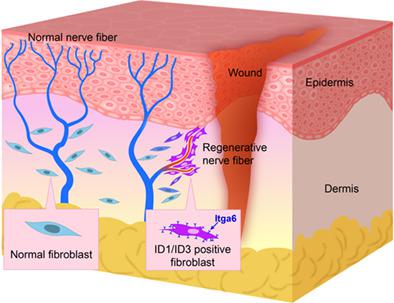当前位置:
X-MOL 学术
›
Stem Cells Transl. Med.
›
论文详情
Our official English website, www.x-mol.net, welcomes your
feedback! (Note: you will need to create a separate account there.)
ID1/ID3 mediate the contribution of skin fibroblasts to local nerve regeneration through Itga6 in wound repair
STEM CELLS Translational Medicine ( IF 5.4 ) Pub Date : 2021-09-14 , DOI: 10.1002/sctm.21-0093 Zelin Chen 1 , Gufang Shen 1 , Xu Tan 1 , Langfan Qu 1 , Can Zhang 1 , Le Ma 1 , Peng Luo 1 , Xiaohui Cao 1 , Fan Yang 1 , Yunsheng Liu 1 , Yu Wang 1 , Chunmeng Shi 1
STEM CELLS Translational Medicine ( IF 5.4 ) Pub Date : 2021-09-14 , DOI: 10.1002/sctm.21-0093 Zelin Chen 1 , Gufang Shen 1 , Xu Tan 1 , Langfan Qu 1 , Can Zhang 1 , Le Ma 1 , Peng Luo 1 , Xiaohui Cao 1 , Fan Yang 1 , Yunsheng Liu 1 , Yu Wang 1 , Chunmeng Shi 1
Affiliation

|
Cutaneous wound healing requires intricate synchronization of several key processes. Among them, local nerve regeneration is known to be vitally important for proper repair. However, the underlying mechanisms of local nerve regeneration are still unclear. Fibroblasts are one of the key cell types within the skin whose role in local nerve regeneration has not been extensively studied. In our study, we found skin fibroblasts were in tight contact with regenerated nerves during wound healing, while rare interactions were shown under normal circumstances. Moreover, skin fibroblasts surrounding the nerves were shown to be activated and reprogrammed to exhibit neural cell-like properties by upregulated expressing inhibitor of DNA binding 1 (ID1) and ID3. Furthermore, we identified the regulation of integrin α6 (Itga6) by ID1/ID3 in fibroblasts as the mechanism for axon guidance. Accordingly, transplantation of the ID1/ID3-overexpressing fibroblasts or topical injection of ID1/ID3 lentivirus significantly promoted local nerve regeneration and wound healing following skin excision or sciatic nerve injury. Therefore, we demonstrated a new role for skin fibroblasts in nerve regeneration following local injury by directly contacting and guiding axon regrowth, which might hold therapeutic potential in peripheral nerve disorders and peripheral neuropathies in relatively chronic refractory wounds.
中文翻译:

ID1/ID3通过Itga6在伤口修复中介导皮肤成纤维细胞对局部神经再生的贡献
皮肤伤口愈合需要几个关键过程的复杂同步。其中,已知局部神经再生对于正确修复至关重要。然而,局部神经再生的潜在机制仍不清楚。成纤维细胞是皮肤内的关键细胞类型之一,其在局部神经再生中的作用尚未得到广泛研究。在我们的研究中,我们发现皮肤成纤维细胞在伤口愈合过程中与再生神经紧密接触,而在正常情况下则显示出罕见的相互作用。此外,通过上调表达 DNA 结合 1 (ID1) 和 ID3 的抑制剂,显示神经周围的皮肤成纤维细胞被激活并重新编程以表现出神经细胞样特性。此外,我们确定了成纤维细胞中 ID1/ID3 对整合素 α6 (Itga6) 的调节作为轴突引导的机制。因此,移植过表达 ID1/ID3 的成纤维细胞或局部注射 ID1/ID3 慢病毒可显着促进皮肤切除或坐骨神经损伤后的局部神经再生和伤口愈合。因此,我们通过直接接触和引导轴突再生证明了皮肤成纤维细胞在局部损伤后神经再生中的新作用,这可能在相对慢性难治性伤口的周围神经疾病和周围神经病变中具有治疗潜力。移植过表达 ID1/ID3 的成纤维细胞或局部注射 ID1/ID3 慢病毒可显着促进皮肤切除或坐骨神经损伤后的局部神经再生和伤口愈合。因此,我们通过直接接触和引导轴突再生证明了皮肤成纤维细胞在局部损伤后神经再生中的新作用,这可能在相对慢性难治性伤口的周围神经疾病和周围神经病变中具有治疗潜力。移植过表达 ID1/ID3 的成纤维细胞或局部注射 ID1/ID3 慢病毒可显着促进皮肤切除或坐骨神经损伤后的局部神经再生和伤口愈合。因此,我们通过直接接触和引导轴突再生证明了皮肤成纤维细胞在局部损伤后神经再生中的新作用,这可能在相对慢性难治性伤口的周围神经疾病和周围神经病变中具有治疗潜力。
更新日期:2021-09-14
中文翻译:

ID1/ID3通过Itga6在伤口修复中介导皮肤成纤维细胞对局部神经再生的贡献
皮肤伤口愈合需要几个关键过程的复杂同步。其中,已知局部神经再生对于正确修复至关重要。然而,局部神经再生的潜在机制仍不清楚。成纤维细胞是皮肤内的关键细胞类型之一,其在局部神经再生中的作用尚未得到广泛研究。在我们的研究中,我们发现皮肤成纤维细胞在伤口愈合过程中与再生神经紧密接触,而在正常情况下则显示出罕见的相互作用。此外,通过上调表达 DNA 结合 1 (ID1) 和 ID3 的抑制剂,显示神经周围的皮肤成纤维细胞被激活并重新编程以表现出神经细胞样特性。此外,我们确定了成纤维细胞中 ID1/ID3 对整合素 α6 (Itga6) 的调节作为轴突引导的机制。因此,移植过表达 ID1/ID3 的成纤维细胞或局部注射 ID1/ID3 慢病毒可显着促进皮肤切除或坐骨神经损伤后的局部神经再生和伤口愈合。因此,我们通过直接接触和引导轴突再生证明了皮肤成纤维细胞在局部损伤后神经再生中的新作用,这可能在相对慢性难治性伤口的周围神经疾病和周围神经病变中具有治疗潜力。移植过表达 ID1/ID3 的成纤维细胞或局部注射 ID1/ID3 慢病毒可显着促进皮肤切除或坐骨神经损伤后的局部神经再生和伤口愈合。因此,我们通过直接接触和引导轴突再生证明了皮肤成纤维细胞在局部损伤后神经再生中的新作用,这可能在相对慢性难治性伤口的周围神经疾病和周围神经病变中具有治疗潜力。移植过表达 ID1/ID3 的成纤维细胞或局部注射 ID1/ID3 慢病毒可显着促进皮肤切除或坐骨神经损伤后的局部神经再生和伤口愈合。因此,我们通过直接接触和引导轴突再生证明了皮肤成纤维细胞在局部损伤后神经再生中的新作用,这可能在相对慢性难治性伤口的周围神经疾病和周围神经病变中具有治疗潜力。











































 京公网安备 11010802027423号
京公网安备 11010802027423号